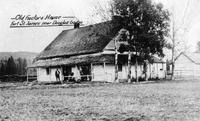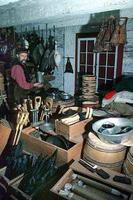Fur Trade, Land-Based
FUR TRADE, LAND-BASED, was a trade for animal pelts carried on between aboriginal peoples and European traders. In Canada it began along the Atlantic coast in the early 16th century when visiting fishers from Europe came ashore to dry their catch, encountered the indigenous people and began to barter with them. Gradually the trade spread across the continent as European colonists established settlements and explorers mapped the waterways of the Interior. The staple fur of the trade was the BEAVER pelt, used by Europeans to manufacture felt hats and other garments, though the skins of many other fur-bearing animals, including MINK, MARTEN, muskrat, FOX, BEAR, LYNX, WOLVERINE and WOLF, were also traded. Actual trapping of the animals was done by aboriginal hunters, who brought their furs to trading posts and exchanged them for guns, metalware, blankets and other imported items. Traders then transported the year's trade to tidewater by CANOES and by ship to Europe.
For many years, trade in the Interior was dominated by the HBC, based in London, England. After Britain defeated France in the Seven Years War and took possession of its Canadian colonies in 1763, other groups of merchants based in Montreal launched an aggressive campaign to rival the HBC. By 1780 these merchants were organized into the NORTH WEST CO (NWC) and were expanding their trading activities as far west as the foothills of the ROCKY MTS. It was at this point that the fur trade reached BC.
The North West Company in BC
A trade in SEA OTTER pelts began along the coast of BC following the visit of Capt James COOK in 1778 (see FUR TRADE, MARITIME) and goods exchanged in this trade made their way to FIRST NATIONS groups in the Interior, but a land-based trade similar to the one being conducted east of the Rockies did not become established on the Pacific slope until the early years of the 19th century. In 1793 aboriginal guides led the NWC trader and explorer Alexander MACKENZIE up the PEACE R, across the Rocky Mts, down the FRASER R and overland to the Pacific at the mouth of the BELLA COOLA R. It was the first crossing of the northern half of the continent by a European. Mackenzie was looking for a plausible trading route linking the Interior to the Pacific and he began to develop plans to exploit the commercial possibilities of the Northwest Coast.
The NWC followed up these plans in 1805 by sending Simon FRASER across the Rockies into the area he christened NEW CALEDONIA, now the central Interior of BC. Fraser and his men built several trading posts: Fort McLeod on McLEOD LK (1805), FORT ST JAMES on Stuart Lk (1806), FORT FRASER on FRASER LK (1806) and Fort George (later PRINCE GEORGE) at the confluence of the Fraser and NECHAKO rivers (1807). These posts mark the real beginning of the land-based fur trade in BC, and until the discovery of gold in the 1850s (see GOLD RUSHES) fur was the area's most significant export. Fraser sought the same route to the Pacific as Mackenzie; in 1808 he descended the river that now bears his name but the ruggedness of the terrain convinced him that traders could not make use of it. Fraser was followed by David THOMPSON, another NWC "Nor'wester." In 1811 he followed the COLUMBIA R to its mouth, where he found the PACIFIC FUR CO already installed. Two years later the NWC bought out the Pacific Fur Co and took sole possession of the trade west of the Rockies.
The Nor'westers based their Columbia trade at a second Fort George, this one located at the mouth of the Columbia. At first, trading posts in the northern district, the area Simon Fraser called New Caledonia, continued to be supplied by canoe brigades from the east. In 1813 a party of Nor'westers led by John STUART pioneered the FUR BRIGADES route connecting the lower Columbia and the upper Fraser posts via the THOMPSON R and the OKANAGAN VALLEY, but the NWC chose not to use this route to supply New Caledonia. The NWC had limited involvement in the maritime fur trade along the coast and was not able to achieve Mackenzie's dream of a sustained trading link with China. It did, however, establish a network of 6 trading posts in what is now BC. Along with the 4 posts mentioned above, these included Fort Kamloops (1813) and FORT ALEXANDRIA (1821).
The Hudson's Bay Company in BC
In 1821, after a period of spirited and sometimes violent competition, the NWC merged with the HBC, which to that point had no presence west of the mountains. The new company retained the HBC name and took over all the NWC posts on the Columbia and in New Caledonia. Under Governor George SIMPSON the HBC reorganized the trade, cutting manpower, readjusting supply routes and encouraging economy. In 1825 the headquarters of the Columbia District moved to Fort Vancouver, farther up the river, from where traders communicated with their inland empire to the north via the Okanagan Valley brigade route pioneered a dozen years earlier. The company also expanded north up the coast, establishing trading posts at FORT LANGLEY (1827), FORT SIMPSON (1831) and FORT McLOUGHLIN (1833). In 1836 the first steam vessel on the northwest coast, the BEAVER, arrived and was put to work supplying posts and collecting furs. In anticipation of the impending border settlement between Great Britain and the US, the HBC opened FORT VICTORIA at the south end of VANCOUVER ISLAND in 1843. Later, after the signing of the OREGON TREATY in 1846, this fort became the headquarters of the company's BC trade.
By the mid-19th century the fur trade was not the sole attraction offered by BC to Europeans. The trade continued, but it contributed progressively less to the provincial ECONOMY as gold, COAL, timber and fish resources began to be exploited. The HBC itself diversified into a range of other economic activities. When the British decided to colonize Vancouver Island in 1849, the company received proprietorial rights to the Island in return for which it was expected to encourage land settlement. This arrangement lasted until 1859, when Great Britain took direct control of the colony. Meanwhile the gold rush of 1858 led to the creation of the mainland colony of British Columbia. The HBC lost its exclusive right to trade and the company now functioned like any other private enterprise. It continued to dominate the fur trade by virtue of its long experience and established infrastructure, but technically the field was open to competitors. By 1870 furs had declined to just 13% of BC's exports, a trend that continued. In time the trading posts either closed or evolved into general stores and the barter trade evolved into the trapping economy.
The impact of the fur trade on BC HISTORY was profound. The presence of traders constituted effective British occupation of the Pacific slope and held the region until the British government was willing to extend formal control in the mid-19th century. Under the auspices of the trade much of the Interior and the West Coast was explored and mapped. The trade's impact on aboriginal people was more equivocal. All evidence suggests that aboriginal people willingly engaged in the trade and welcomed the useful material goods it provided. They had long traded among themselves and were experienced negotiators who managed to establish a more or less equitable relationship with the European traders. It has also been argued that the wealth produced by the fur trade, along with the access to iron tools, contributed to a cultural flowering among coastal First Nations, as evidenced by an increase in wood carving and an elaboration of the POTLATCH. However, contact with outsiders brought tragic side effects—principally epidemic diseases, and especially SMALLPOX—that sharply reduced the aboriginal population (see ABORIGINAL DEMOGRAPHY).
Reading: Richard Somerset Mackie, Trading Beyond the Mountains: The British Fur Trade on the Pacific, 1793–1843, 1997.


